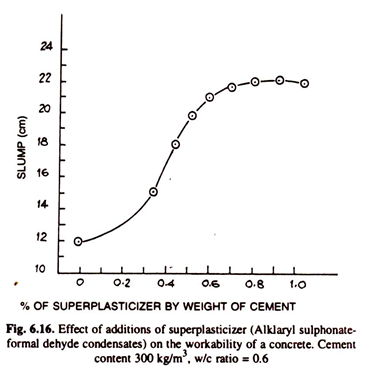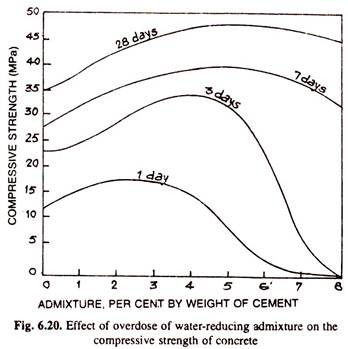By nominal dosages of plasticizers or super plasticizers the improvement in the workability of very stiff or zero slump concrete has not been observed. A mix having 20 mm to 30 mm initial slump can only be fluidised by the use of plasticizers or super plasticizers. To fluidify a no slump concrete a high dosage is required. An improvement in slump may be obtained upto the extent of 250 mm depending upon the initial slump of the mix, dosage and cement content.
It has been observed that slump increases with the dosage, but after a certain limit of the dosage, slump starts decreasing. After about 1.0% dosage by weight of cement, slump starts decreasing. A typical curve showing the effect of dosage of super plasticizer on slump is shown in Fig.6.16.
The improved workability developed due to the use of super plasticizers lasts only for a short duration. It has been observed that this improvement in workability lasts only from 30 minutes to 90 minutes. Some researchers have found this period from 30 minutes to 120 minutes. Hence the rate of loss of slump is very steep. After this period of 90 to 120 minutes the workability returns to normal. Hence it is recommended that Plasticizers or super plasticizers should be added to concrete just prior to placing.
1. Effect of Super Plasticizers on Setting of Concrete:
ADVERTISEMENTS:
The effect of the use of super plasticizers on the setting of concrete is not found significant except in the case of cements having very low contents of C3A. If the C3A contents are very low the retardation of setting of cement may be very significant. However the other long term properties are not appreciably affected.
The only real disadvantage of super plasticizers is the relatively high cost due to the expenses of manufacturing a product of a high molecular mass.
2. Effect of Super Plasticizers on the Properties of Concrete:
The super plasticizers or plasticizers do not take part in any chemical reaction with cement or blending material such as fly ash used in concrete. The action of plasticizers or super plasticizers in fluidizing the mix is only physical made even with low water content. Their fluidifying action lasts only as long as the mix is in plastic condition. Once the effect of adsorption layer is lost, the hydration process continues normally. It has been proved experimentally that the right quality of plasticizers or super plasticizers used upto 3.0% by weight of cement produces no bad effect on the properties of hardened concrete.
However the bad quality ligno sulphate based plasticizers have resulted in the air entrainment, thereby reducing the strength of concrete. As the plasticizers and super plasticizers improve workability and compactability, results in the reduction of water/cement ratio, thereby increasing the strength of concrete. It results in the al-round improvement in the properties of the hardened concrete. Nowadays the use of plasticizers or super plasticizers has become a practice to obtain high performance concrete.
ADVERTISEMENTS:
When the plasticizers or super plasticizers are used in higher dose, the strength development is reduced significantly beyond one day upto 7 days. However seven day strength and beyond, the reduction will not be appreciable. The effect of ligno-sulphonate type of super plasticizers on strength development is shown in Fig. 6.20.
When it is desired to achieve the high strength of concrete with a given water/cement ratio, the water content may be reduced by 25 to 35% by weight of cement by the use of super plasticizers, whereas with the use of conventional water reducing -admixture the reduction of water may be about one half of the above value. The effect of the use of super plasticizers on the early strength of concrete (3 days) is shown in Fig. 6.20.
Further following points should be remembered:
ADVERTISEMENTS:
1. At the same water/cement ratio, naphthalene or melamine based super plasticizers have not been found to modify the drying shrinkage of concrete considerably. Some times at the same consistency they have been found to reduce the drying shrinkage appreciably.
2. At high water/cement ratio of the order of 0.64, the total creep is found higher with the use of naphthalene sulphonates whereas at low water/cement ratio the difference in creep between with and without plasticizers is insignificant.
3. Durability of concrete is the function of its impermeability, which depends on water/cement ratio. Hence super plasticizers enhance the durability of concrete. Super plasticizers due to the reduction in water/cement ratio, reduce the penetration of chlorides and sulphates into the concrete and thus improve the resistance to the sea water or deicing effect.
The resistance to sulphate attack also has increased due to the same reason. Thus it can be concluded that with the use of plasticizers or super plasticizers reduction in water/cement ratio of concrete can be effected without effecting the workability of concrete, and producing stronger concrete. Thus the use of super plasticizers will contribute to the all-round improvement in the properties of concrete.

